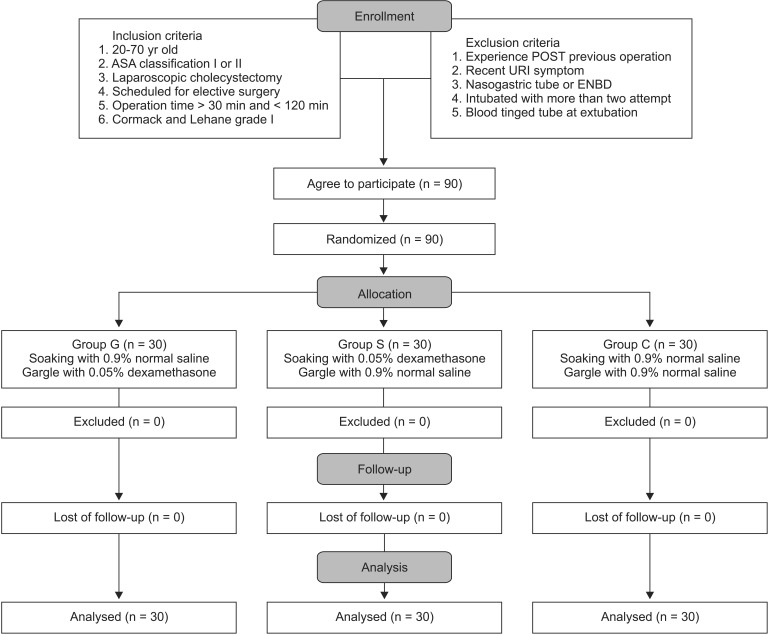1. Christensen AM, Willemoes-Larsen H, Lundby L, Jakobsen KB. Postoperative throat complaints after tracheal intubation. Br J Anaesth. 1994; 73:786–787. PMID:
7880666.

2. Loeser EA, Bennett GM, Orr DL, Stanley TH. Reduction of postoperative sore throat with new endotracheal tube cuffs. Anesthesiology. 1980; 52:257–259. PMID:
7369513.

3. Kang H, Kim KJ, Baek CW, Woo YC, Kim JY, Park SG. The effect of cuff pressure of laryngeal tube on postoperative sore throat after general anesthesia using N2O. Korean J Anesthesiol. 2006; 50:266–271.

4. Safavi M, Honarmand A, Fariborzifar A, Attari M. Intravenous dexamethasone versus ketamine gargle versus intravenous dexamethasone combined with ketamine gargle for evaluation of post-operative sore throat and hoarseness: A randomized, placebo-controlled, double blind clinical trial. Adv Biomed Res. 2014; 3:212. PMID:
25371869.

5. Lee JH, Lee HK, Chun NH, So Y, Lim CY. The prophylactic effects of gabapentin on postoperative sore throat after thyroid surgery. Korean J Anesthesiol. 2013; 64:138–142. PMID:
23459631.

6. Ahmed A, Abbasi S, Ghafoor HB, Ishaq M. Postoperative sore throat after elective surgical procedures. J Ayub Med Coll Abbottabad. 2007; 19:12–14. PMID:
18183710.
7. Jarahzadeh MH, Fuladgar B, Mirjalili MR, Rahimi-Bashar F, Dehghani MH, Barzegar K. Effect of local application of dexamethasone on reducing of post-surgical sore throat due to application of laryngeal mask airway. J Biol Today's World. 2014; 3:271–274.

8. Rashwan S, Abdelmawgoud A, Badawy AA. Effect of tramadol gargle on postoperative sore throat: A double blinded randomized placebo controlled study. Egypt J Anaesth. 2014; 30:235–239.

9. Banihashem N, Alijanpour E, Hasannasab B, Zarei A. Prophylactic effects of lidocaine or beclomethasone spray on post-operative sore throat and cough after orotracheal intubation. Iran J Otorhinolaryngol. 2015; 27:179–184. PMID:
26082898.
10. Agarwal A, Gupta D, Yadav G, Goyal P, Singh PK, Singh U. An evaluation of the efficacy of licorice gargle for attenuating postoperative sore throat: a prospective, randomized, single-blind study. Anesth Analg. 2009; 109:77–81. PMID:
19535697.

11. Haider HS, Al-Ali BT. The role of dexamethasone in reducing the severity of postoperative sore throat. Iraqi Postgrad Med J. 2013; 12:454–459.
12. Jeong SH, Park SH, Ok SM, Huh JY, Ko MY, Ahn YW. The effects of corticosteroid solutions in olp patients. J Oral Med Pain. 2012; 37:27–33.

13. Bagchi D, Mandal MC, Das S, Sahoo T, Basu SR, Sarkar S. Efficacy of intravenous dexamethasone to reduce incidence of postoperative sore throat: A prospective randomized controlled trial. J Anaesthesiol Clin Pharmacol. 2012; 28:477–480. PMID:
23225928.

14. Park SY, Kim SH, Lee AR, Cho SH, Chae WS, Jin HC, et al. Prophylactic effect of dexamethasone in reducing postoperative sore throat. Korean J Anesthesiol. 2010; 58:15–19. PMID:
20498806.

15. Rudra A, Ray S, Chatterjee S, Ahmed A, Ghosh S. Gargling with ketamine attenuates the postoperative sore throat. Indian J Anaesth. 2009; 53:40–43. PMID:
20640076.
16. Saleem J, Athar S. Incidence of postoperative sore throat and cough: comparison of a polyvinylchloride tube and an armoured tube. Crit Care. 2008; 12:337.

17. Hwang GB, Lee SI, Park HS, Chung CJ. Incidence of sore throat after tracheal intubation and postoperative. Korean J Anesthesiol. 1997; 33:533–539.

18. Higgins PP, Chung F, Mezei G. Postoperative sore throat after ambulatory surgery. Br J Anaesth. 2002; 88:582–584. PMID:
12066737.

19. Kim WJ, Oh HK. A clinical study of sore throat after endotracheal intubation. Korean J Anesthesiol. 1977; 10:143–148.

20. Huang YS, Hung NK, Lee MS, Kuo CP, Yu JC, Huang GS, et al. The effectiveness of benzydamine hydrochloride spraying on the endotracheal tube cuff or oral mucosa for postoperative sore throat. Anesth Analg. 2010; 111:887–891. PMID:
20581162.

21. Sumathi PA, Shenoy T, Ambareesha M, Krishna HM. Controlled comparison between betamethasone gel and lidocaine jelly applied over tracheal tube to reduce postoperative sore throat, cough, and hoarseness of voice. Br J Anaesth. 2008; 100:215–218. PMID:
18024955.

22. Rao M, Snigdha , Alai T, Vijay K. Instillation of 4% lidocaine versus air in the endotracheal tube (ETT) cuff to evaluate post intubation morbidity-a randomized double blind study. J Anesth Clin Sci. 2013; 2:19.

23. Streeten DH. Corticosteroid therapy. J AM Med Assoc. 1975; 232:944–948.

24. González-Moles MA, Scully C. Vesiculo-erosive oral mucosal disease--management with topical corticosteroids: (1) Fundamental principles and specific agents available. J Dent Res. 2005; 84:294–301. PMID:
15790732.

25. Park AR, La HO, Cho BS, Kim SJ, Lee BK, Rhie JY, et al. Comparison of budesonide and dexamethasone for local treatment of oral chronic graft-versus-host disease. Am J Health Syst Pharm. 2013; 70:1383–1391. PMID:
23903476.

26. Choung YH, Cho MJ, Kim CH, Lee J, Kang SO. Preliminary results of steroid gargle treatment and clinical characteristics of patients with burning mouth syndrome. Korean J Otolaryngol-Head Neck Surg. 2004; 47:569–574.
27. Mayhood J, Cress K. Effectiveness of ketamine gargle in reducing the incidence of postoperative sore throat in patients undergoing airway instrumentation: A systematic review protocol. JBI Database System Rev Implement Rep. 2015; 13:244–278.
28. Hung NK, Wu CT, Chan SM, Lu CH, Huang YS, Yeh CC, et al. Effect on postoperative sore throat of spraying the endotracheal tube cuff with benzydamine hydrochloride, 10% lidocaine, and 2% lidocaine. Anesth Analg. 2010; 111:882–886. PMID:
20304980.

29. González-Moles MA, Scully C. Vesiculo-erosive oral mucosal disease--management with topical corticosteroids: (2) Protocols, monitoring of effects and adverse reactions, and the future. J Dent Res. 2005; 84:302–308. PMID:
15790733.





 PDF
PDF Citation
Citation Print
Print




 XML Download
XML Download